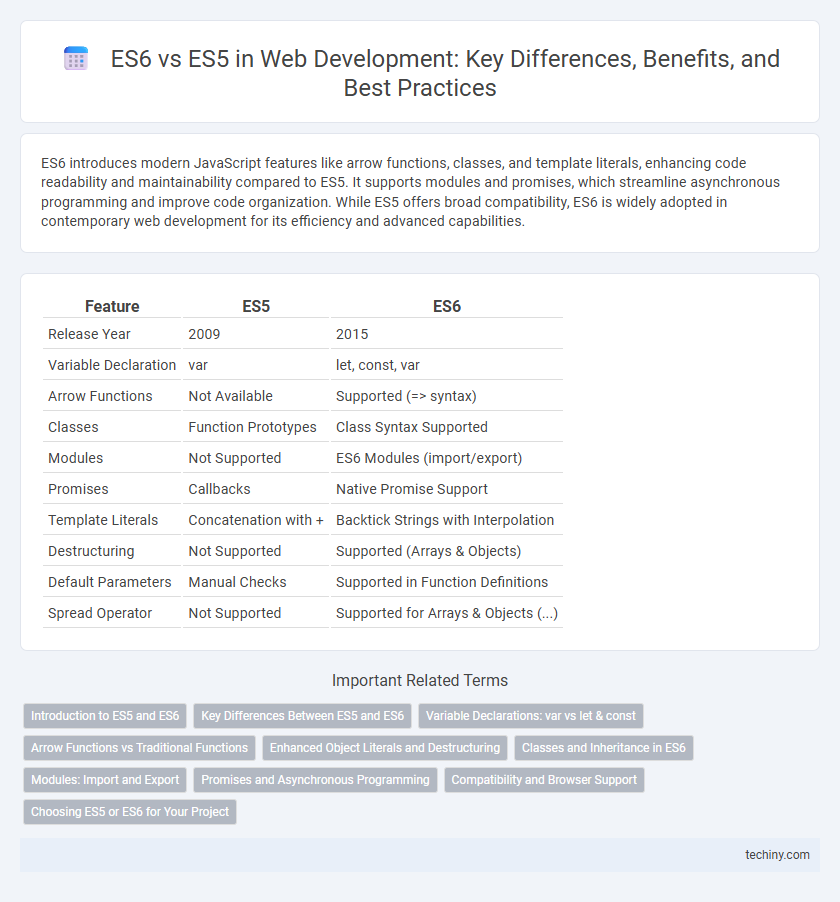ES6 introduces modern JavaScript features like arrow functions, classes, and template literals, enhancing code readability and maintainability compared to ES5. It supports modules and promises, which streamline asynchronous programming and improve code organization. While ES5 offers broad compatibility, ES6 is widely adopted in contemporary web development for its efficiency and advanced capabilities.
Table of Comparison
| Feature | ES5 | ES6 |
|---|---|---|
| Release Year | 2009 | 2015 |
| Variable Declaration | var | let, const, var |
| Arrow Functions | Not Available | Supported (=> syntax) |
| Classes | Function Prototypes | Class Syntax Supported |
| Modules | Not Supported | ES6 Modules (import/export) |
| Promises | Callbacks | Native Promise Support |
| Template Literals | Concatenation with + | Backtick Strings with Interpolation |
| Destructuring | Not Supported | Supported (Arrays & Objects) |
| Default Parameters | Manual Checks | Supported in Function Definitions |
| Spread Operator | Not Supported | Supported for Arrays & Objects (...) |
Introduction to ES5 and ES6
ES5, or ECMAScript 5, introduced foundational features like strict mode, enhanced object manipulation methods, and improved JSON support, setting a baseline for modern JavaScript development. ES6, also known as ECMAScript 2015, brought significant advancements including arrow functions, classes, template literals, and modules, making code more concise and maintainable. The transition from ES5 to ES6 marks a pivotal evolution in JavaScript, enhancing both developer productivity and code readability.
Key Differences Between ES5 and ES6
ES6 introduced significant improvements over ES5, including arrow functions that provide a shorter syntax and lexical `this` binding, which simplifies callbacks and closures. Block-scoped variables declared with `let` and `const` replace the function-scoped `var`, enhancing code predictability and reducing errors. ES6 also adds modules for better code organization, template literals for easier string interpolation, and promises for improved asynchronous programming compared to ES5's callbacks.
Variable Declarations: var vs let & const
ES6 introduced let and const for variable declarations, providing block scope and reducing issues related to hoisting and redeclaration common with var in ES5. Let allows reassignment within block scope while const creates read-only references, enhancing code predictability and maintainability. Using let and const improves JavaScript code quality by preventing accidental global variable creation and promoting clearer intent compared to var's function scope and variable hoisting behavior.
Arrow Functions vs Traditional Functions
Arrow functions in ES6 provide a concise syntax and lexically bind the `this` value, improving callback readability and reducing common errors with traditional function expressions in ES5. Unlike ES5 traditional functions, arrow functions do not have their own `this`, `arguments`, or `prototype`, making them ideal for non-method functions and preserving context in nested callbacks. Developers often prefer ES6 arrow functions for cleaner code and consistent scope handling in modern JavaScript applications.
Enhanced Object Literals and Destructuring
ES6 introduced enhanced object literals, allowing shorthand property names, method definitions, and computed property keys, which streamline object creation and improve code readability compared to ES5. Destructuring in ES6 provides a concise syntax to extract values from arrays or objects into distinct variables, significantly reducing the need for repetitive accessors present in ES5. These features contribute to cleaner, more maintainable web development code by enhancing expressiveness and reducing boilerplate.
Classes and Inheritance in ES6
ES6 introduced class syntax, simplifying object-oriented programming compared to ES5's prototype-based inheritance. Classes in ES6 provide cleaner, more intuitive syntax for defining constructors and methods, improving code readability and maintainability. ES6 also supports inheritance through the extends keyword and super function, enabling easier subclass creation and parent method access.
Modules: Import and Export
ES6 introduced native modules with `import` and `export` statements, enabling cleaner and more maintainable code by explicitly defining dependencies and exports. Unlike ES5, which relied on patterns like CommonJS or AMD for modularity, ES6 modules support static analysis, enabling better optimization and tree-shaking during bundling. This modernization enhances code scalability, promotes reuse, and improves performance in modern web development workflows.
Promises and Asynchronous Programming
ES6 introduced Promises, revolutionizing asynchronous programming by enabling cleaner and more manageable code compared to ES5's callback-based approach. Promises in ES6 allow developers to handle asynchronous operations with methods like .then() and .catch(), reducing callback hell and improving error handling. ES6's asynchronous capabilities paved the way for modern syntax like async/await, further enhancing code readability and maintainability.
Compatibility and Browser Support
ES5 offers broad compatibility across all modern and legacy browsers, making it the safest choice for projects targeting a wide range of environments. ES6 introduces advanced features like arrow functions and classes but requires transpilation with tools like Babel to maintain compatibility with older browsers such as Internet Explorer 11. Choosing ES6 can enhance code readability and performance, but developers must implement polyfills or bundlers to ensure seamless experience across diverse browser versions.
Choosing ES5 or ES6 for Your Project
Choosing between ES5 and ES6 for your project depends on browser support requirements and developer familiarity. ES6 offers modern features like arrow functions, classes, and template literals that enhance code readability and maintainability, while ES5 ensures compatibility with older browsers without the need for transpilation. Evaluating the target audience's browser usage and project complexity helps determine whether to prioritize cutting-edge syntax or broader compatibility.
ES6 vs ES5 Infographic

 techiny.com
techiny.com